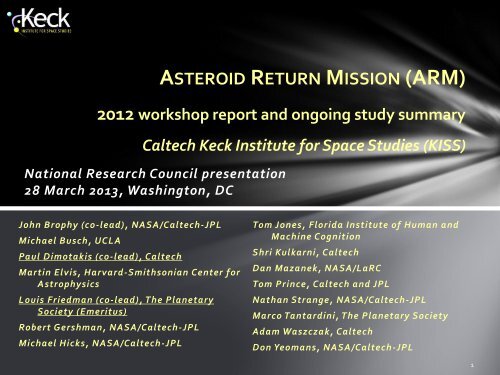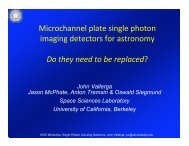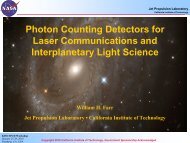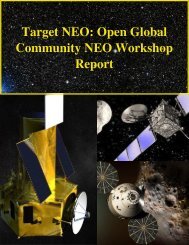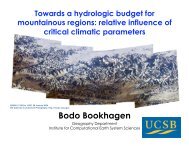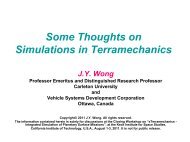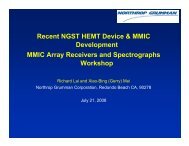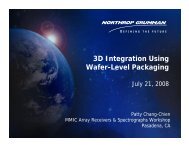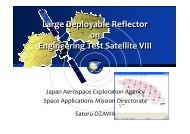Asteroid Return Mission - Keck Institute for Space Studies - Caltech
Asteroid Return Mission - Keck Institute for Space Studies - Caltech
Asteroid Return Mission - Keck Institute for Space Studies - Caltech
- No tags were found...
Create successful ePaper yourself
Turn your PDF publications into a flip-book with our unique Google optimized e-Paper software.
National Research Council presentation28 March 2013, Washington, DCASTEROID RETURN MISSION (ARM)2012 workshop report and ongoing study summary<strong>Caltech</strong> <strong>Keck</strong> <strong>Institute</strong> <strong>for</strong> <strong>Space</strong> <strong>Studies</strong> (KISS)John Brophy (co -lead), NASA/<strong>Caltech</strong>-JPLMichael Busch, UCLAPaul Dimotakis (co-lead), <strong>Caltech</strong>Martin Elvis, Harvard-Smithsonian Center <strong>for</strong>AstrophysicsLouis Friedman (co-lead), The PlanetarySociety (Emeritus)Robert Gershman, NASA/<strong>Caltech</strong> -JPLMichael Hicks, NASA/<strong>Caltech</strong> -JPLTom Jones, Florida <strong>Institute</strong> of Human andMachine CognitionShri Kulkarni, <strong>Caltech</strong>Dan Mazanek, NASA/LaRCTom Prince, <strong>Caltech</strong> and JPLNathan Strange, NASA/<strong>Caltech</strong> -JPLMarco Tantardini, The Planetary SocietyAdam Waszczak, <strong>Caltech</strong>Don Yeomans, NASA/<strong>Caltech</strong> -JPL
Phase 1: KISS Workshop on the feasibility of an asteroid-capture &return mission• Completed in early 2012• Study co-leads from <strong>Caltech</strong>, JPL, and The Planetary Society• Broad invitation and participation (17 national/international organizations)• April 2012 report on the WebObjectives:<strong>Asteroid</strong>-return mission (ARM) study ― I• Assess feasibility of robotic capture and return of a small near-Earth asteroidto a near-Earth orbit, using technology that can mature in this decade.• Identify potential impacts on NASA and international space community plans<strong>for</strong> human exploration beyond low-Earth orbit.• Identify benefits to NASA/aerospace and scientific communities, and to thegeneral public.http://www.kiss.caltech.edu/study/asteroid/index.html
<strong>Asteroid</strong>-return mission (ARM) study ― IIPhase 2: Three-part follow-on and technical-development study• October 2012 start, on-going• Three main study components:• Observational campaign to search, and develop the technology to find andcharacterize suitable Near-Earth <strong>Asteroid</strong>s (NEAs)• Development of the asteroid capture mechanism (not presented today)• In-space concentrating solar-thermal technology (not presented today)A NASA-sponsored study recently began at JPL on this concept• The KISS studies and this presentation are independent of the NASAsponsoredJPL ef<strong>for</strong>thttp://www.kiss.caltech.edu/study/asteroid/index.html
Create:• An attractive destination <strong>for</strong> humans that is close-to/beyond the Moon• A high-value and accessible place <strong>for</strong> human-exploration operations andexperience• A stepping stone into the Solar System and on a flexible path to MarsProvide:Why bring an asteroid?• Opportunity <strong>for</strong> human operational experience beyond the Moon• Robotic spacecraft retrieval of valuable resources <strong>for</strong> human, robotic, andhuman-robotic synergistic exploration, and potential utilization of materialalready in space• Science, technology, and engineering elements relevant to planetary defenseWithin current/known constraints, it’s a way <strong>for</strong> humans to reach anasteroid by the mid-2020s.
Bringing a (small) asteroid ― GuidelinesSmall size:• d ast ~ 5 − 7 m , m ast ≲ 750 tons ± ;low Earth-frame speed (u ast,i ≲ 2.6 km/s)Composition:• Carbonaceous (C-type), density/strength of“dried mud”• A rubble pile would break up<strong>Space</strong>craft trajectory/controlStable destination orbit:• E-M L2, high lunar orbit, or other stable orbitThese guidelines coincide with safety:• Required trajectory coincides with a non-collision course• Desired asteroid would burn-up high in Earth’s atmosphere, should it enter• Chelyabinsk reference: d Ch,i ~ 15 − 17 m, m Ch,i ≅ 11,000 tons;u Ch,i ≅ 19 km/sImage credit: http://ccar.colorado.edu/asen5050/projects/projects_2012/wolma/img/earth_moon_l_pts.jpg
Apollo program returned~ 400 kg of moon rocks, oversix missions.OSIRIS-REx mission plans toreturn ~ 0.06 kg of surfacematerial from a B-type near-Earth asteroid (NEA) by 2023.This study is evaluating thefeasibility of returning anentire ~7m NEA, with a mass~5 × 10 5 kg ±, to either L2 ora high lunar orbit, by 2026.ARM perspectiveImage credits: NASA Apollo and OSIRIS-REx mission
Target asteroids ― IChelyabinskAbsolute Magnitude HTarget asteroid
Table from Brophy et al. 2012 <strong>Asteroid</strong> Retrieval Feasibility. KISS final report.Target mass: m ast ~ 500 tons ±• Max : m ast ~ 1000 tons• Density uncertainty: most NEAdensities are in the range1.9 ≲ ρ ast ≲ 3.9 g/cm 3• For reference: m ISS ~ 500 tonsPrelim. spin rate: ≲ 10 rphImparted ∆V ≲ 0.2 km/s• Max ∆V~2.6 km/s with lunar-gassist• Depends on target-asteroid massTarget asteroids ― IIDiameter<strong>Asteroid</strong> Mass (kg)(m) 1.9 g/cm 3 2.8 g/cm 3 3.8 g/cm 32.0 7,959 11,729 15,9172.5 15,544 22,907 31,0893.0 26,861 39,584 53,7213.5 42,654 62,858 85,3074.0 63,670 93,829 127,3394.5 90,655 133,596 181,3095.0 124,355 183,260 248,7095.5 165,516 243,918 331,0326.0 214,885 316,673 429,7706.5 273,207 402,621 546,4157.0 341,229 502,864 682,4597.5 419,697 618,501 839,3948.0 509,357 750,631 1,018,7148.5 610,955 900,354 1,221,9099.0 725,237 1,068,770 1,450,4739.5 852,949 1,256,977 1,705,89810.0 994,838 1,466,077 1,989,675Must identify enough candidates that meet requirements to plan a robustmissionFor candidate asteroid, we need to know:• Orbit, spectral type (C-type), size, shape, spin state, mass, and synodic period• Uncertainties must be small enough to enable flight-system development
Finding target asteroids ― Current statusPresent surveys:• Relatively complete down to 1km• Numerous detections down to 100m• Poor knowledge of population down to 10mSmall number of plausible ARM candidatesidentified, e.g., 2009 BD, based onmagnitude and orbit• Present NEO detection rate: ~1000 /year• Present ARM candidate rate: 2 − 3/year*• Discoveries are mostly serendipitousNo “gold-plated” ARM candidates (suitable orbit, known size, spin,composition) presently knownObservations are mostly ground-based optical• Some space IR opportunities, e.g., NEOWISE, SpitzerCatalina Sky Survey*V ∞ test, size-type screening, spin, 2020-25 Earth close approach, … (≤ 1% suitable <strong>for</strong> ARM).
Finding target asteroids - The challengeVery dim: 10m object is 100’s of timesfainter than a 100m object (5 magnitudes)• Must be detected close to EarthLarge angular rate (“trailed” on images) ,only visible <strong>for</strong> small number of nights (~10)<strong>for</strong> ground-based surveysDetection requires large field of view andlarge apertures (typically > 1m)2013 BS45 “flight accessible”Palomar Transient Factory (PTF)
Increase NEO discovery rate to ~10/dayYield: ~5 good targets per year (right size, type, spin state, and orbitalcharacteristics)Rapid follow-on with a suite of facilities:• Refined astrometry (orbit), multi-band photometry (colors), time-resolvedphotometry (light curves), spectroscopy (C-type or not), radar (size, density,spin), thermal IR (mass/area)Decrease uncertaintiesObservational campaign ― What’s neededTime sincediscoveryRate(#/day)< 12 hrs 10 AstrometryFollow-up observation< 24 hrs 0.5 Additional astrometry, colors< 48 hrs 0.2 Light curves< 48 hrs 0.1 Spectroscopy< 72 hrs 0.06 RadarTable derived from Brophy et al. 2012 <strong>Asteroid</strong> Retrieval Feasibility. KISS final report.
<strong>Asteroid</strong> Capture and <strong>Return</strong> (ACR) spacecraft15.0 m10.0 mCapture BagDeployedSolar Array Wing40 kW EOLSEP system36 deg10.7 m<strong>Space</strong>craft BusStructure5.9 m5.8 m2.7 m35.7 mHall ThrustersConceptual flight-system design by the NASA/GRC COMPASS team, with guidance by the KISS team(Brophy et al. 2012 <strong>Asteroid</strong> Retrieval Feasibility. KISS final report).
Conceptual ACR spacecraft ― IITop:• Solar arrays folded back tofacilitate matching the asteroidspin state during the captureprocessBottom:• Conceptual ACR flight systemconfiguration be<strong>for</strong>e capturemechanismdeployment• Shows camera locations on solararray yokes used to verify properdeployment and subsequentlyaid in asteroid captureCrushable FoamFor <strong>Asteroid</strong>CaptureRadiatorCamera <strong>for</strong><strong>Asteroid</strong> CaptureStowed Inflatable<strong>Asteroid</strong> CaptureBagRadiatorKa-Band ReflectArray, TWT, EPC,and RadiatorCamera <strong>for</strong><strong>Asteroid</strong> Capture10.7 meterUltraflex SolarArray10.7 meterUltraflex SolarArrayConceptual flight-system design by the NASA/GRC COMPASS team, with guidance by the KISS team(Brophy et al. 2012 <strong>Asteroid</strong> Retrieval Feasibility. KISS final report).
Conceptual ACR spacecraft ― IIIMaster Equipment List (MEL)Launch vehicle capability to LEO: 18,000 kgConceptual flight-system design by the NASA/GRC COMPASS team, with guidance by the KISS team(Brophy et al. 2012 <strong>Asteroid</strong> Retrieval Feasibility. KISS final report).
Solar Electric PropulsionEnvisaged ACR propulsion:• Solar power: 40 kW (EOL), 50 kW (BOL)• Hall thrusters: 4 thrusters, 10 kW each, operatingin parallel• Consistent with current NASA Solar Array System (SAS)contract objectives: 30 − 50 kW range• Xenon mass: m Xe ≤ 13 tons at launch• Specific impulse: I sp ~ 3000 s• Thrust level: T = 1.5 N• Adequate <strong>for</strong> ≤ 1300 ton favorable-orbit asteroid return• Assessed as the lowest-risk ARM-propulsion option todayDawn, <strong>for</strong> reference:• Solar power: 10 kW solar array (BOL, 1 AU)• EP power: 2.5 kW• Xenon mass: m Xe ~ 0.425 tons at launch• SEP cost: $1M/kW <strong>for</strong> the solar arraysImage credit: http://htx.pppl.govSEP is assessed to be an enabling technology <strong>for</strong> ARM
Proof-of-concept trajectory ― 2008 HU4Heliocentric frame• Indicated ‘tof’ times begin with the completion of a ~ 2.2 year spiral-outEarth-escape phase.Initial launch mass:m i ~ 18 tons<strong>Return</strong> mass: m r ~1300 tonsMass amplification:m rm i> 70: 1Total flight time: τ f ~10 years• <strong>Return</strong> time fixed by asteroid orbit• Target asteroid mass uncertaintytranslates into launch-mass andlaunch date (tof) uncertaintyFrom Brophy et al. 2012 <strong>Asteroid</strong> Retrieval Feasibility. KISS final report.
Proof-of-concept trajectory ― 1998 KY26<strong>Mission</strong> options depend on target asteroid characteristicsAlternate: “Boulder” option• Carbonaceous 1998 KY26• Initial launch mass: 18 tons• <strong>Return</strong> mass: 60 tons ~4 m• Whole 1998 KY26 too big to return• Period/orbit: 500 days0.98 × 1.5 AU• Total flight time: 5.3 years• Mass amplification: 3.5: 1Identification of optimal targets and uncertainty reduction (mass, +)is crucial to ARMFrom Brophy et al. 2012 <strong>Asteroid</strong> Retrieval Feasibility. KISS final report.
Proof-of-concept trajectory ― 2009 BDTrajectory illustration <strong>for</strong>an alternate targetGeocentric/sun-upreference frame• Earth-centered radialtangential-normal(RTN)frame• No wonder the ancientshad troubleComputer-animation credit: Nathan Strange, NASA/<strong>Caltech</strong>-JPL
<strong>Mission</strong> description6. <strong>Asteroid</strong> Operations(90 days: Deploy bag, captureand de-tumble asteroid)<strong>Asteroid</strong> Orbit5. Cruise to <strong>Asteroid</strong>(1.7 years) 7. <strong>Return</strong> toLunar Orbit(2 to 6 years)9. Transfer tohigh Lunar orbitMoon’s Orbit2. Separation &S/A Deployment4. Lunar Gravity Assist3. Spiral Outto Moon (2.2 years)8. Lunar Gravity Assist407 km LEO Circular Orbit1. LaunchAtlas V 551EarthBrophy et al. 2012 <strong>Asteroid</strong> Retrieval Feasibility. KISS final report.
<strong>Mission</strong>-destination optionsEarth-Moon L2 or High Lunar OrbitOrbit stability may favor latterHalo orbit around L2 is also understudyImage credit: www.spudislunarresources.comLower figures from Brophy et al. 2012 <strong>Asteroid</strong> Retrieval Feasibility. KISS final report.
Planet safetyMultiple and independent safety layers and factors• A 7 m diameter asteroid is too small to be considered a potentially hazardousasteroid (PHA)• Will not survive entry• Low mass and approach velocity• Earth entry (initial) energy would be much lower than the Chelyabinsk meteor’s:E e = 1 2 m eU e 2 ≲ 0.001 × E Ch,i• <strong>Mission</strong>-design trajectories guide the captured asteroid on a non-collisioncourse with Earth• Failure and loss of control would leave a harmless asteroid in orbit around the sun• Final orbit destinations chosen <strong>for</strong> its stability• L2, stable high lunar orbit, or other sufficiently stable orbit
Robotic-human synergyARM would be the first truly robotic precursor since Surveyor<strong>Asteroid</strong> observations and composition are important to solar-systemstudies and to putative solar-system exploitation• e.g., volatiles, metals• ARM could enable new commercialization optionsWhile ARM is not aimed at planetary defense, there are synergies• Planning <strong>for</strong> planetary defense benefits from detailed knowledge ofpotentially hazardous asteroids• composition• structure• capture or deflection technologies
Robotic-human synergy ― MilestonesARM launch<strong>Asteroid</strong> captureEmplacement near MoonHuman mission(s)Scientific studyCommercial options?2017 2022 2025 2026 …
Title page: http://esamultimedia.esa.int/docs/GES_Framework_final.pdfInternational cooperation ― IEventual human mission may wellbe internationalARM could be a/the first step inThe Global Exploration Strategy(May 2007)Robotic mission admits andinvites many af<strong>for</strong>dablecooperative possibilities
International cooperation ― IIRobotic sample return is an international pursuit• Stardust, OSIRIS-REx (NASA)• Hayabusa 1 and 2 (JAXA)• Marco Polo (ESA)Solar Electric Propulsion is an international thrustOptions <strong>for</strong> international roles include:• Companion observing spacecraft, e.g., IKAROS free-flying camera• Payload participation, e.g., High Energy Neutron Detector• Major subsystem, e.g., capture deviceThe NEO observing ef<strong>for</strong>t is also international
ARM ― Summary and conclusionsCreates a compelling, exciting, reachable target beyond the Moon <strong>for</strong>next step in explorationMay provide the only possibility <strong>for</strong> humans to reach an asteroid bythe mid-2020sCreates a meaningful human science, technology, and operationsexperience, with a significant public-appeal potentialAdvances robotic SEP to enable this mission conceptRequires uncertainty reduction <strong>for</strong> ARM successHas technology tangencies with planetary defenseRepresents a new synergy between robotic and human missions <strong>for</strong>exploration, science, technology, and applications developmentOffers a plat<strong>for</strong>m and an opportunity that would host and extendinternational cooperation
Thank youImage credit: Rick Sternbach / <strong>Keck</strong> <strong>Institute</strong> <strong>for</strong> <strong>Space</strong> <strong>Studies</strong>
Back-up material
Carl Allen, NASA/JSCKISS ARM workshop (Phase-1) participantsDamon Landau, NASA/<strong>Caltech</strong>-JPLDavid Baughman, Naval Postgraduate SchoolJulie Bellerose, NASA ARCBruce Betts, The Planetary SocietyJohn Brophy (co-lead), NASA/<strong>Caltech</strong>-JPLMike Brown, <strong>Caltech</strong>Michael Busch, UCLAJohn Casani, NASA/<strong>Caltech</strong>-JPLMarcello Coradini, ESAFred Culick (co-lead), <strong>Caltech</strong>John Dankanich, NASA/GRCPaul Dimotakis, <strong>Caltech</strong>Martin Elvis, Harvard-Smithsonian Center <strong>for</strong> AstrophysicsLouis Friedman (co-lead), The Planetary SocietyIan Garrick-Bethell, UCSCRobert Gershman, NASA/<strong>Caltech</strong>-JPLTom Jones, Florida <strong>Institute</strong> <strong>for</strong> Human and MachineCognitionChris Lewicki, ArkydAstronauticsJohn Lewis, U. ArizonaPedro Llanos, USCMark Lupisella, NASA GSFCDan Mazanek, NASA/LaRCPrakhar Mehrotra, <strong>Caltech</strong>Joe Nuth, NASA/GSFCKevin Parkin, NASA/ARCRusty Schweickart, B612 FoundationGuru Singh, NASA/<strong>Caltech</strong>-JPLNathan Strange, NASA/<strong>Caltech</strong>-JPLMarco Tantardini, The Planetary SocietyBrian Wilcox, NASA/<strong>Caltech</strong>-JPLColin Williams, NASA/<strong>Caltech</strong>-JPLWillie Williams, NASA/<strong>Caltech</strong>-JSCDon Yeomans, NASA/<strong>Caltech</strong>-JPL
Conceptual ACR spacecraft ― IIITop:• Stowed configurationBottom:• Bottom view of the conceptualACR spacecraft showing thefive 10-kW Hall thrusters andthe RCS thruster clusters.4 Pods of 4 RollControl ThrustersRoll ControlThruster5 Total HallThrusters andGimbalsHall Thruster andGimbalConceptual flight-system design by the NASA/GRC COMPASS team, with guidance by the KISS team(Brophy et al. 2012 <strong>Asteroid</strong> Retrieval Feasibility. KISS final report).
Solar Electric Propulsion ― IICurrent vision is <strong>for</strong> EP system components to be qualified at thecomponent level (as was done <strong>for</strong> the Dawn mission):• Hall thrusters• Power-processing units (PPUs)• Thruster gimbals• Solar arrays• Solar-array drive assemblies• ++Flight system design is dominated by• The size of the xenon tanks (m Xe ≤ 13 tons)• Solar-array accommodation in stowed configuration• Thermal-system design to reject ~3 kW PPU waste heat


